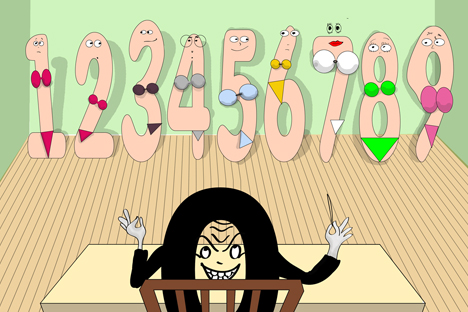
Click to enlarge the cartoon. Drawing by Niyaz Karim
When students get marks in Russian schools, they typically come in the form of numbers ranging from one to five. While the word for those numbers may be simple, they can have multiple meanings.
1. Although edinitsa (the number one, odin) is technically the lowest mark (“very poor”), in practice it is given only in exceptional cases — generally not for knowledge, but for behavior. Another term for it is “stake.” In addition, a one-room apartment (one room and kitchen) is called an odinushka.
2. Dvoika, or two, signifies “unsatisfactory.” Around 20 years ago, a television with a built-in VCR was called a videodvoika. A two-room apartment is called a dvushka. However, if you ask an older person what dvushka means, he will undoubtedly say that it is a two-kopek coin, which in the Soviet era was used to make calls from pay phones, and it was therefore the object of a particular request.
3. Troika, or three, means “satisfactory.” This word has entered many languages; it refers to the three horses harnessed to a traditional Russian wagon. However, today the word troika is used more often to refer to a men’s suit that includes, in addition to a jacket and pants, a third component: a vest.
A three-room apartment is known as a treshka. In Soviet times, this was a paper bill worth three rubles (another name for it was troyak). From the 1950s through the 1970s, when a bottle of vodka cost around three rubles, there was a popular male scenario, a leisure activity called soobrazit’ na troikh, “splitting a bottle three ways”: three men (usually strangers) would each contribute one ruble in a liquor store, buy a half-liter bottle of vodka and split it three ways (they would take turns using a single chipped glass) somewhere nearby, seasoning the ritual with heartfelt conversation.
4. Chetverka, four, means “good.” There is also the common word chetvert’, or “quarter,” which is used, for example, to mean “quarter of an hour.” Hence the literal way to say 11:15 in Russian is “quarter of the 12th [hour],” while 11:45 translates as “without a quarter, 12.” Chetvert’ also designates the four periods the school year is divided into (there are vacations between the quarters).
5. Pyaterka (five, or “excellent”) also referred to a five-ruble bill in Soviet times. Nowadays, the word’s dual meaning is used in the name of the popular brand name of the Pyaterochka supermarket chain (the customer needs to combine two associations: otlichno [“excellent”] and nedorogo [“inexpensive”]).
Under the Soviet regime, a five-kopek coin was called a pyatak, and it was in great demand because it was inserted into the automated turnstiles in subway stations (the price of a ride, five kopeks, did not change for several decades).
A short form of the word, pyatochok, was the word for a piglet’s snout (it looks like the coin — at the time, the pyatak was the most valuable coin in circulation). From there the word pyatak returned to coarse slang, where the expression dat’ v pyatak (literally, “to hit in the five”) came to mean “to punch in the face.” The hand — because it has five fingers — is called a pyternya, and the expression “Dai pyat’!,” or “Give me five!,” is a vernacular invitation for a friendly handshake.
6. Shestyorka, six, is the least valuable card in a 36-card deck of playing cards. This is why in prison slang shestyorka is a disparaging term for the person who occupies the lowest rung in the criminal hierarchy. In common usage, for several decades shesterka was a term for the most popular, sixth model of the mass-produced domestic Zhiguli automobile.
7. Semerka, seven, is first and foremost associated with the film “The Magnificent Seven,” the popular American Western from around 50 years ago that was released in the Soviet Union under the title Velikolepnaya semerka.
8. Vos’merka, eight, is a bent bicycle tire.
9. Devyatka, nine, is the upper corner of a football goalpost — scoring a goal there is considered the pinnacle of skill. Devyatka is also the name for another popular (the ninth) Zhiguli model, and the name for the strongest type of Baltika beer, which bears the number nine and a 9 percent alcohol content (it is believed that mainly hard-core alcoholics drink devyatka).
10. Desyatka, 10, is the center of a shooting target; the expression popast’ v desyatku, literally, “to land on the 10,” means “to do something very precisely and correctly.” Until recently, desyatka was also the word for the 10-ruble bill, which is now gradually being replaced by a coin.
50. A 50-ruble bill is called a poltinnik (that is, polovina, or “half,” of a hundred). In the Soviet era, poltinnikalso referred to the 50-kopek coin; it is interesting that in terms of purchasing power, the poltinniks of different periods (after all inflations and denominations), turn out to be more or less consistent.
100. A 100-ruble bill is known as a sotnya, or stol’nik in its slang variant. Then, there is sotka, a unit for measuring area (100 square meters); in common usage, this word is heard primarily in the combination shest’ sotok, or “600 square meters.”
These were the dimensions of the land given to city dwellers for their household gardens — and now “600 square meters” means “a standard modest country house.” The word sto, “one hundred,” can be used in a number of expressions to mean “high level of something.”
For example, Stopudovo! is a confirmed promise (“Absolutely!”), while vyglyadyt’ na vse sto, literally “to look like a complete hundred,” means “to look wonderful.”
Dvoika, troika, chetverka and so on used to designate bus routes in city transport. This is still the case in small cities, but in Moscow, where most bus routes have three-digit numbers, this is becoming more rare.
All rights reserved by Rossiyskaya Gazeta.
Subscribe
to our newsletter!
Get the week's best stories straight to your inbox